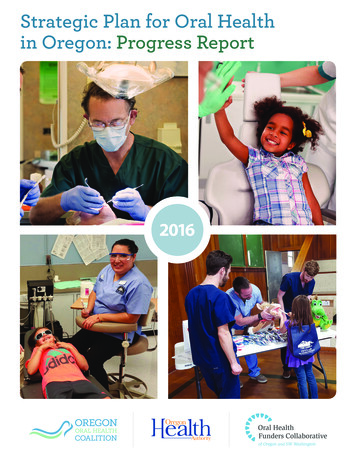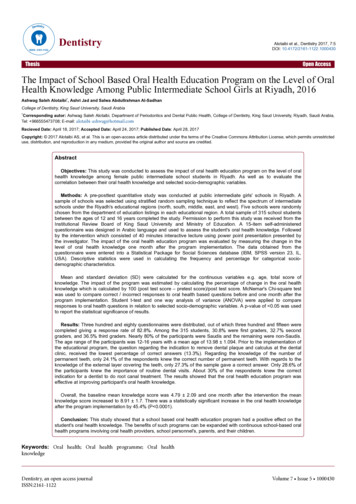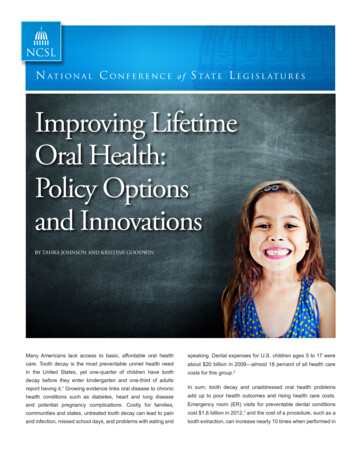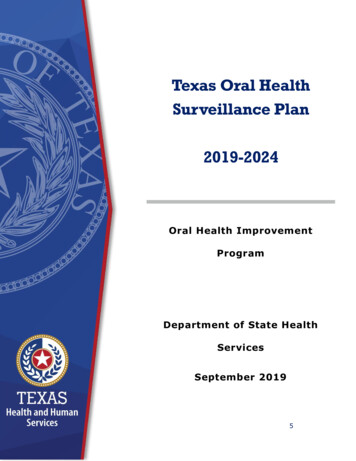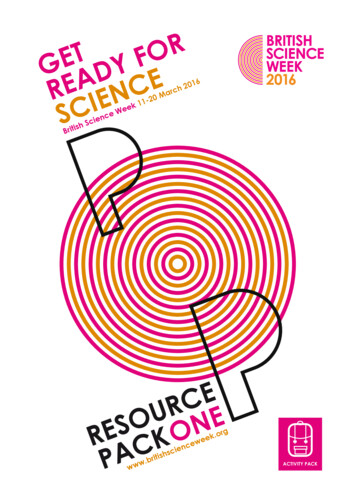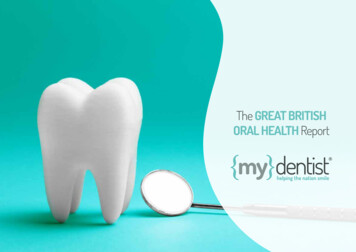
Transcription
The GREAT BRITISHORAL HEALTH Report
EXECUTIVE SUMMARYThe Great British Oral Health Report is themost comprehensive survey of oral healthdata in Britain, combining a new nationalsurvey of patient attitudes with the latestpublished evidence in the dental sector togive an insight into the oral health of thecountry and the challenges that lie ahead.The findings are clear: millions of patientsare struggling to access NHS dentistry,there is a growing gulf between the Northand South of the country, and fundingpressures and an acute shortage of NHSdentists mean hundreds of dental practicesmay have to close in the years ahead.An estimated ten million people in the UKare currently waiting for routine dentaltreatment and 19 million appointmentshave been missed during the pandemic,according to the British Dental Association.Public opinion on access to care showshow acute the crisis currently is. Nearly60% of people feel that it is harder toaccess an NHS dentist now than it wasten years ago and Healthwatch Englandhas shown that 85% of dental practicesare closed to new adult patients withsignificant variations across the countryforming a “North-South” divide.Although oral health has improved in thelast thirty years, inequalities based ondeprivation and geography have widened,creating a post code lottery in care. In 2008,the proportion of children with dentaldecay was 2.9x higher in the most deprivedthan the least deprived areas. In 2019, thisincreased by a third to be 3.8x higher.The Oral Health Survey suggests this gapcould continue to widen as pressurescaused by the pandemic continue tomount and access to NHS dentistrybecomes ever more restricted.To improve access to NHS dentistry aroundthe UK, especially for the most deprivedcommunities, there is strong public supportnationwide for the recruitment of highlyskilled dentists from overseas, with nearlyfour-out-of-five people (78%) supportingoverseas recruitment of skilled clinicians.The GREAT BRITISH ORAL HEALTH Report : 2
THE ORAL HEALTH SURVEYAT A GLANCE86% of people think that access to emergency dental careshould be a high priority for the NHS, with 64% thinkingnon-urgent dentistry should be a high priority.53% of the public have not had a routine dentalcheck-up in the last year:High or low priority serviceIn general, how high or low priority do you think each of the followingshould be currently for the NHS?Most recent check-upFor the above question, by ‘routine check-up’, we mean a general check-upperformed by your dentist to examine your teeth and gums, and to give advice.Valid 2,026Valid 2,026Non-urgent dentistry services (e.g.check-ups, fillings, cosmetic work etc)2% I have never had a routine check-upUrgent dentistry services (e.g.emergency tooth extraction)2% Longer than 10 years ago33% Within thelast 6 months5% Longer than 5 years ago,within the last 10 years15% Longer than 2 yearsago, within the last 5 years10% Longer than 6 monthsago, within the last year22% 44%41% 40%25% 8%6%1%Very highpriorityFairly highpriorityFairly lowpriorityVery lowpriority6%6%Don’tknow63% 84%31% 9%Net: HighPriorityNet: LowPriority24% Longer than a yearago, within the last 2 yearsThe GREAT BRITISH ORAL HEALTH Report : 3
THE ORAL HEALTH SURVEYAT A GLANCENearly 70% of respondents have wanted to see a dentist in the last two years,but data shows only 43% of people managed to get an appointment in the twoyears leading up to April 2021. This suggests that more than 14 million peopletried and were unable to get a dental appointment in the last two years.Of those who had not seen a dentist in the last year, 28% could not get anappointment, 16% were unable to afford NHS dentistry and 14% said theywere unable to register for a routine check-up with an NHS dentist.Reasons for wanting to visit a dentist within last 2 years.Reasons for not visiting a dentist for a routine check-up within the last year.Which of the following,if any, are your reasons for not visiting a dentist within the last year?Unweighted 1,059Unweighted 1,0592% Prefer not to say4% Other3% I have been unable totravel to the nearest dentistfor a routine check-up1% Don’t know/can’t recall1% To treat mouth ulcers5% For cosmetic dental treatment5% To treat bleeding gums43% For a routinedental check-up4% Don’t know5% My usual dentalpractice has closed14% I have a general fearof going to the dentist2% I have been unable toregister for a routine check-upwith a private dentist1% Prefer not to say28% My usual dentalpractice did not haveany appointments/wasunable to see me for aroutine check-up12% Other12% Due to dental pain14% I have been unable toregister for a routine check-up with an NHS dentist12% To replace missingor broken teeth34% Not applicable - I have notwanted to visit a dentist for any reasonin particular within the last two years15% I have COVID-19 relatedfear/anxiety about seeing adentist for a routine check-up20% I have not feltthat I have requireda routine check-upwithin the last year16% I have been unable to afford tosee a dentist for a routine check-upThe GREAT BRITISH ORAL HEALTH Report : 4
THE ORAL HEALTH SURVEYAT A GLANCE78% support the recruitment of highly skilled dentistsfrom outside of the UK to fill the gap of NHS dentists.58% of people think access to NHS dentistry has got worsein the last decade, with 40% saying it is now “much moredifficult”. Only 7% say it is easier.Easier or harder to see NHS dentistThinking about now (2021) in comparisonto 10 years ago, in general, how mucheasier is it to see an NHS dentistSupport or oppose highly skilled dentistsfrom outside the UKThe Association of Dental Groups has arguedthat there is currently a shortage of dentistsin the UK. To what extent would you supportor oppose highly skilled dentists from outsidethe UK being recruited?Unweighted 2,02618% 40% 18%7%58%38% 40%6%3%13%78%10%A little easierNo differentA little more difficultNet: EasierNet: HarderStrongly supportTend to opposeStrongly opposeDon’t knowNet: SupportNet: OpposeTend to support17%Don’t know4%Much more difficult2%Much easierUnweighted 2,026The GREAT BRITISH ORAL HEALTH Report :5
THE ORAL HEALTH SURVEYNearly 70% of the populationhas at least one fillingNumber of fillingsHow many fillings do youcurrently have?Unweighted 2,026AT A GLANCE(I have natural teeth & no fillings)None14%1 to 216%3 to 423%5 to 1021%More than 107%Don’t know/can’t recall13%Not applicable3%Prefer not to say2%Net: Had at least 1 filling67%(I do not have any natural teeth )Nearly 40% of the public are unhappy with theappearance of their teeth.Happy or unhappy with appearance of teethIn general, how happy are you with theappearance of your teeth?Unweighted 2,026Very happy14%Fairly happy 48%Fairly unhappy 26%Very unhappy12%Don’t know2%Prefer not to say2%Not applicable3%(don’t have natural teeth)The GREAT BRITISH ORAL HEALTH Report : 6
1. ACCESS TO NHS DENTISTRY58%of the public feelaccessing an NHS dentistis harder now than it wasten years ago85%of dental practices wereclosed to new NHS adultpatients with 60% beingclosed to new childNHS patients12millioncourses of treatmentswere carried out bygeneral dentists in theyear 2020-21, down69% compared to theprevious year9millionchildren have missed outon dental care in the yearfollowing the first lockdown,with the percentage ofchildren being seen fallingfrom 58.7% to 23%There is a growing crisis in accessingNHS dentistryThe COVID-19 pandemic has made the accesscrisis worse.Data from the {my}dentist Oral Health Survey ofpatients found that 53% of respondents had not had adental check-up in the last year. Of these, nearly 60%said the reason was either an inability to get an NHSappointment with their dentist (28%), because theywere unable to register to an NHS dental practice(14%), or because they could not afford a routine NHScheck-up (16%).The COVID-19 pandemic has exacerbated thisproblem, leading to an estimated 10 million patientswaiting for routine treatment. BDA analysis of Freedomof Information data indicates that nearly 70% ofappointments – or 28 million courses of treatment– that would have been delivered in NHS services inEngland in the year since the start of the pandemichave been missed (BDA survey, 25 May 2021).A report from the watchdog Healthwatch England in2019 found that 85% of dental practices were closed tonew NHS adult patients and 40% were closed to newNHS child patients, (HealthWatch England submissionto the Health and Social Care Select Committee, 2019,link). The data from the {my}dentist Oral HealthSurvey supports these statistics, demonstratingthat approximately 60% of the public feel that it hasbecome harder to visit an NHS dentist for any type ofappointment compared to ten years ago, with 40%reporting it has become much more difficult and 18%reporting it has become a little more difficult. Only 7%of respondents said it has become easier to get an NHSdental appointment of any type.New data from the latest NHS Dental Statisticsreleased by NHS Digital shows that only 12 millioncourses of treatment were carried out by generaldentists in the year 2020-21, down 69% compared tothe previous year. Worryingly, 9 million children havemissed out on dental care in the year following the firstlockdown (defined as March 2020 to February 2021),with the percentage of children being seen fallingfrom 58.7% to 23%. (NHS Dental Statistics for England2020-21 Annual Report, 26th August 2021).The number of NHS practices across the UK isfalling, affecting a growing number of patientsThe total number of dental surgeries offering NHStreatment has fallen from 9,661 in 2014-2015 to 8,408in 2019-2020. A Freedom of Information request sentto the Care Quality Commission also showed that thenumber of practices that closed between 2019-20and 2020-21 increased by 13% from 843 to 949. (FOIrequest, CQC, 2021).NHS Digital said that 18.2 million adults were not seenby an NHS dentist in the 24 months up to 30 June2021. The number of adults seen in the 24 months upto April 2021 dropped from 49.6% to 42.8% than in thesame 24-month comparison up to April 2020. (NHSDental Statistics for England 2020-21 Annual Report,26th August 2021).53% of of the respondents from the {my}dentistsurvey said they have received no dental care in thelast year, the start of the pandemic in the UK.This is despite nearly 70% of the public wanting tosee a dentist.Over 20% of the respondents reported they hadto perform “DIY dentistry” as they could not see adentist - 3% people purchased a temporary fillingkit, 1.4% resorting to extracting their own teeth and17% taking antibiotics or over-the-counter painkillers.Figures released by Boots said that ‘at-home’ repair kitswhich facilitate re-cementing crowns and temporarilyreplacing lost fillings were up by 87% in the last quarterof 2020, compared to 2019.The GREAT BRITISH ORAL HEALTH Report : 7
There is a growing postcode lottery in access toNHS careThis has risen dramatically from 50% in 2016 and 68%in 2017.There is significant regional variation in access to NHSdental care. In the South-West, just 7.7% of dentalpractices are taking on new patients. More than 50,000people are on waiting lists for NHS dentistry in Cornwalland the city of Portsmouth now no longer has a singledental practice accepting new NHS patients.Many dentists are moving away from NHS dentistry,with 50% of dentists having sought to reduce theirNHS hours over the last three years. This is reflectednationally, with the number of clinical hours workedper dentist in the UK down 10 percentage points from2008. New NHS digital data suggests that the numberof dentists performing NHS activity in 2020-21 is 951down from the previous year. (NHS Dental Statistics forEngland 2020-21 Annual Report, 26th August 2021)11% more people had a routine check up in the South ofEngland than the North of England. 56% of respondentssaid they had to wait over a year to get a routine checkup in the North compared to 50% in the South.There are also variations between countries in theUnited Kingdom. In England and Scotland over 40%of respondents said they had a routine check-upwithin one year, whereas in Wales not even a third ofrespondents claimed the same (31%).In total, 16 million people do not have a dentist. In the24-month period ending 30 June 2020, just over 21million adult patients were seen by an NHS dentist,fewer than 50% of the population (NHS Digital, NHSDental Statistics for England 2019-20, 29 August2019, link).A growing number of patients feel they cannotafford dentistryPrivate dentistry is not an option for much ofthe population and is considered by many to beunaffordable. 16% of the population cannot afford NHSdental care let alone private dental care. This is skewedacross England, with 74% of respondents seeing anNHS dentist in the North relative to 49% in the South. Onthe flipsside only 29% see a private dentist in the Northrelative to 45% in the South.The access crisis is being fuelled by an acuteshortage of dentistsA survey by the British Dental Association found that75% of dental practices are now struggling to fill longterm vacancies (BDJ, 12 April 2019, link). This rises to 84%among practices with the highest NHS commitments.58% of NHS dentists are planning to retire from NHSdentistry within the next five years. Over half (53%) ofyoung and newly qualified NHS dentists aged under35 intend on leaving the NHS in the same period. Thisis particularly true of EU-trained dentists, who delivermore than 22% of all NHS dentistry, and up to 30% inmost deprived areas. (British Dental Association, 2017)The access crisis is putting pressure on thewider NHSThe access issue is adding pressure to the wider NHS.Approximately 600,000 GP consultations, and morethan 200,000 A&E visits, take place for patients withdental problems every year. (British Dental Association,2016)The British public want urgent action to supportNHS dentistry63% of respondents said that they believe routine, nonurgent dentistry should be a priority for the government.When asked if urgent dental care should be a priority ofthe government, 84% stated it should be a high priority,44% of which said it should be a very high priority.The {my}dentist Oral Health Survey found that thepublic strongly support the recruitment of highlyskilled dentists from overseas to increase access toNHS dentistry. Nearly four-out-of-five people (78%)supported overseas recruitment.The GREAT BRITISH ORAL HEALTH Report : 8
2.THE STATE OF ORAL HEALTH IN GREAT BRITAIN38%of respondents wereA third of British adults have untreatedtooth decayunhappy with theappearance of their teethwith over one-in-tenstating they were“very unhappy”23.4%of 5-year-old childrenin England hadexperience ofdental decay11gYoung people are stillconsuming the equivalent ofaround 8 sugar cubes morethan the recommendeddaily limit – often eating11g just at breakfast1/3A third of thepopulation is sufferingfrom untreatedtooth decay970,000families have children whoseteeth have needed to be extractedin hospital under generalanaesthetic, while a further1.2 million families havechildren where a tooth wasextracted by thegeneral dentistPeople are becoming increasingy unhappywith their teethThe latest data from the {my}dentist OralHealth Survey found that 38% of respondentswere unhappy with their smile, with overone-in-ten stating they were “very unhappy”. Asimilar survey in 2019 found that this was as highas half the population, with teeth coming third ina list of things people stress most about behindfinances and relationships. (Independent articleon Straight Teeth Direct Survey, 2019)A Public Health England survey in 2018 foundthat 18% of the population had experiencedone of more of the following oral problems:inability to pronounce words, difficulty in eating,embarrassment, self-consciousness or apainful aching in the mouth (National DentalEpidemiology Programme for England, Oralhealth survey of adults attending general dentalpractices, Public Health England, 2018).Data from the same Public Health England surveyshows that 27% of the adult population haduntreated tooth decay on an average of two teeth.This means that nearly a third of the populationis suffering from untreated tooth decay. This washigher in men (31.5%) than women (23.6%) andmost prevalent in those agreed 25 to 34 (35.3%).It was also found that participants who had notattended a dentist for 2 years or more were morelikely to have untreated tooth decay (48.8%).Severe tooth decay which affects the toothpulp in adults was found in 11.7% of participants,was higher in men (15.4%) than women (9.3%).(National Dental Epidemiology Programme forEngland, Oral health survey of adults attendinggeneral dental practices, Public Health England,2018)This matches the statistics from our recent{my}dentist Oral Health Survey, which found that67% of the population had at least one filling andover 50% more than three. 80% people had theirfirst filling under the age of 30, which included59% who had their first filling under the age of18 as children, suggesting a failure of preventativeoral health measures in society.The {my}dentist Oral Health Surveydemonstrated that a quarter of British peopleonly brushed their teeth once a day, despite therecommended minimum being twice per day.Although in absolute terms tooth decay has fallenin severity over the last half-century, it is still themost common disease in the world. If tooth decayis not treated with preventative measures earlyon, it can lead to holes in teeth, dental abscessesor spreading infections in the head and neck.These all need an intervention from a dentist,with the intervention depending on the severityof the problem. Fillings, root canal treatment,dental crowns, tooth extractions and, in rarecases, surgery to reduce facial swelling, are someof the options available. A high-frequency sugardiet, poor oral hygiene, smoking and genetics arefactors that can increase the risk of tooth decay.(NHS, 2021)According to Public Health England, whilechildren’s sugar intakes have fallen slightly inrecent years, young people are still consuming theequivalent of around 8 sugar cubes more thanthe recommended daily limit – often eating 11gjust at breakfast. Consuming too much sugar canlead to an increased risk of obesity and long termconditions such as type 2 diabetes. (PHE, 2019)Another report from Public Health England in2019 found that 23.4% of 5-year-old children inEngland had experience of dental decay. Thiswas similar to the finding of the previous surveyof 5-year-old children in 2017, where 23.3% ofthe surveyed children had experience of dentaldecay. At the age of five, children normallyhave primary, or “milk teeth,” usually twenty innumber. The same study found that amongthe 23.4% of children with experience of dentaldecay, the average number of teeth that weredecayed were 3.4. Although from 2008 to 2017the proportion of children that experienced toothdecay fell from 30.9% to 23.3%, there has beenno further improvement since. This means nearlya quarter of the five-year-old population in theUK experience tooth decay. (National DentalEpidemiology Programme for England, Oralhealth survey of adults attending general dentalpractices, Public Health England, 2018)The GREAT BRITISH ORAL HEALTH Report : 9
When tooth decay progresses irreversibly inchildren the only solution is tooth extraction,which in most cases has to happen undergeneral anaesthetic in hospital. The literatureshows that one child is admitted to hospital fortooth extractions in the UK every 10 minutes.There were over 45,000 extractions of multipleteeth in children in England in 2017/18. This isa 22% increase on the 36,833 in 2012/13. 322children had full mouth clearances in 2017/18,losing all their teeth in one operation. In theirtotality, this is the costliest operation to the NHS(Counting the cost of tooth extractions, BDA 2018)The latest figures from the {my}dentist OralHealth Survey suggest that 970,000 familieshave children whose teeth have needed to beextracted in hospital under general anaesthetic,while a further 1.2 million families have childrenwhere a tooth was extracted by the generaldentist. (Using ONS Statistics of 19.4millionfamilies in UK, 2020, and {my}dentist Oral HealthSurvey data).Out of these children who had missed school,52% had to miss one day, 19% missed two daysand 8% missed three days, as tooth decay cancause problems with eating and sleeping as wellas causing pain. Public Health England estimatethat at least 60,000 days are missed fromschool during the year for hospital extractionsalone (Public Health England, Child Oral Health:Applying All Our Health, 2019).likely in those who have not seen a dentist inmore than two years (60.9%) than who hadseen a dentist within two years (52.1%) (NationalDental Epidemiology Programme for England,Oral health survey of adults attending generaldental practices, Public Health England, 2018).The {my}dentist Oral Healthy Survey found that5% of the population wanted to visit the dentistto treat bleeding gums.Although we are keeping more of our teethas we age, 73% of people have one or moremissing back teeth and 7.6% of people had oneor more missing front teeth (National DentalEpidemiology Programme for England, Oralhealth survey of adults attending general dentalpractices, Public Health England, 2018).The number of new cases of mouth cancerin the UK has increased by 58% in the lastdecadeOver half of British people have signs ofgum diseaseOver half the population (52.9%) of Great Britainhave gingivitis. This is more common in men(56.5%) than in women (50.4%) and increasinglyDiagnoses of mouth cancer is increasing in theUK, with one person every hour being diagnosedwith the disease. It is the 14th most commoncancer in the UK, but 9th most common formen. It accounts for 2% of all cancers diagnosedin the UK (The State of Mouth Cancer Report,Oral Health Foundation November 2020). Thenumber of new cases of mouth cancer in the UKwas 8,772 in 2019, which is a 5% increase in theyear before, a 58% increase since the last decadeand a 97% increase compared to 20 years ago(ibid) Men are more likely to have mouth cancerthan women, with over two-thirds of patientsbeing male. Mouth cancer also has a strongrelationship with age, with more than 75% ofcases being in the population over 55 (ibid). Thereare different types of mouth cancers, but manyof them can be life-threatening. Last year, 2,702people in the UK lost their lives to the disease.This is a 48% increase in deaths compared with10 years’ ago (ibid).Mouth cancer is referred from your generaldentist to a specialist team at the hospitals.Since the beginning of the COVID-19 lockdown,referrals have fallen by 65% according to oneof England’s biggest NHS Trusts. When dentalpractices were closed due to COVID-19, anestimated 10 million patients missed out ontreatment or appointments. The literatureshows that during this time, 16% of people haveexperienced at least one of the potential earlywarning signs of mouth cancer and have beenunable to seek professional help (ibid).The GREAT BRITISH ORAL HEALTH Report : 10
3.ORAL HEALTH INEQUALITIESOral health inequalities between childrenare wideningDecay among children was 3.8x higher in the mostdeprived communities compared to the least deprivedcommunities in 2019, compared to 2.9x higher in 2008(Inequalities in Oral Health in England, PHE, 19 March2021). The number of people suffering from oral healthproblems, many of which are entirely preventable,hs reduced in the last few decades. However,the difference between affluent and deprivedcommunities is still a significant public health problem.The below table from Public Health England showsthe difference in the rate of tooth extractions betweenthe most deprived communities and the leastdeprived communities.3.8x50%There is a reported 50%higher relative risk ofdeath from mouth cancerfor those residents in themost deprived Index ofMultiple Deprivation quartilecompared to the leastdeprivedDecay among children was3.8x higher in the mostdeprived communitiescompared to the leastdeprived communities in2019, compared to 2.9xhigher in 200834%of respondents with ahousehold income of less than 20,000 had seen a dentistfor a routine check-up withinthe last year compared to46% of those with householdincomes greater than 20,000For example, tooth decay amongst 5 year olds variedacross regions from 18% in the South East to 32% inthe North West. The prevalence of untreated activetooth decay also varied widely, ranging from 7% in EastSussex to 48% in Blackburn with Darwen and showeda strong “North-South divide.” (Inequalities in OralHealth in England, PHE, 19th March 2021).There is a clear positive correlation between grosshousehold income and the percentage of adults whohad a routine check-up within the last year.Index of Multiple Carious toothDeprivationextractionsEngland QuintileThe {my}dentist Oral Health Survey found that34% of respondents with a household income ofless than 20,000 had seen a dentist for a routinecheck-up within the last year relative to 46% of thosewith household incomes greater than 20,000. Thisincreased to 59% in households with incomes greaterthan 60,000.A similar story was found with participants performing“DIY dentistry”. Those with a lower household incomewere more likely to perform “DIY dentistry” thanthose with greater household incomes. Those withhousehold incomes less than 20,000 were threetimes more likely to have extracted one of theirown teeth than those with household incomesabove 20,000.A study on survival after mouth cancer was diagnosedshowed significant social inequalities only within thefirst 18 months. It reported a 50% higher relative riskof death for those residents in the most deprivedIndex of Multiple Deprivation quartile compared to theleast deprived. This difference was not explained afteradjusting for age, gender, pathology stage, tumour site,year of surgery and adjuvant radiotherapy. Oral cancermortality is considerably worse in the North West,North East and Yorkshire than the rest of the country.People are 20% more likely to die from oral healthcancer in the North West than in the South East(PHE 2020)QuintilepopulationTooth extractionrate per 100,000population1 (most 436,0802,504,350242.7844,1492,391,983187.255 (least 87282.50The GREAT BRITISH ORAL HEALTH Report : 11
ORAL HEALTH INEQUALITIESA growing north-south divideThe Great British Oral Health Report hasalso identified a growing gap betweenthe north and the south, and betweendifferent social groups.There are several particular hot spotsacross the UK where patients arefinding it harder to access care. Peoplein the North East, for example, weremost likely to have not been to thedentist in over 10 years and twice aslikely to have used a temporary filling kitthan the national average. People livingin the North East are most likely to havenot received any type of dental caresince the start of the pandemic.Similarly, people living in the SouthWest of England are most likely tolive more than 5 miles away from adentist, and when they do go to thedentist, are most likely to need to goprivately. People in the South West alsosupport the recruitment of highly skilleddentists from outside the UK more thanpeople in any other region.People in the East of England are mostlikely to have been unable to afford tosee a dentist for a routine check-up inthe last year, and are more likely to havehad their first filling aged 18 or younger,while people in the East Midlands aremost likely to be either fairly or veryunhappy with the appearance of theirteeth, and are more likely to brush theirteeth less than twice a day than peoplein any other region.25% of people in the North East have been to the dentist in thelast 6 months, compared to 39% of people in the South East64% of people in the North West find it harder to see an NHS dentist nowthan they did 10 years ago, compared to 52% of people in the East MidlandsOver 50% of patients in the South West had to chooseprivate care for their last dentist appointment, morethan in any other part of the countryPeople in the South West are most likely to support therecruitment of highly skilled dentists from outside the UK(85%), compared to the national average of 78%People in the South West are twice as likely than the nationalaverage to live more than 30 miles away from a surgery24% of people in the West Midlands have five or moremissing teeth, compared to the national average of 18%22% of people in the North West have been unable toregister for a routine check-up with an NHS dentist in thelast year, compared to the national average of 14%People in the East Midlands are most likely to be either fairlyor very unhappy with the appearance of their teeth (44%),compared to 38% of people nationally23% of people in the East of England have been unable toafford to see a dentist for a routine check-up in the last year,compared to the national average of 17%37% of people in the East Midlands brush their teeth less than twice a day,compared to the national average of 28%, and are 15% more likely thanpeople in the South East (22%) to brush their teeth less than twice a day41% of people in Yorkshire and the Humber reported that their usual dentalpractice did not have any appointments or was unable to see them for aroutine check-up over the last year, compared to 28% of people nationallyPeople in the North East are 15% more likely than those in theSouth East to have not received any type of dental care sincethe start of the pandemic (58% vs 43%)The GREAT BRITISH ORAL HEALTH Report : 12
METHODOLOGY ANDACKNOWLEDGEMENTSThe Great British Oral Health Reportwas written by Dr Vinay Raniga forand on behalf of {my}dentist, theUK’s leading provider of NHS dentistry.Data contained within the report isfrom a mixture of public sources (citedthroughout the document) and a newsurvey run in
The Great British Oral Health Report is the most comprehensive survey of oral health data in Britain, combining a new national survey of patient attitudes with the latest published evidence in the dental sector to give an insight into the oral health of the country and the challenges that lie ahead. The findings are clear: millions of patients .


